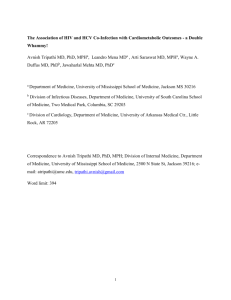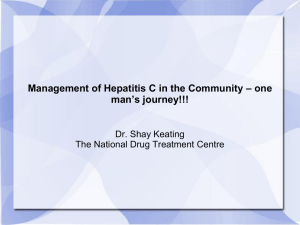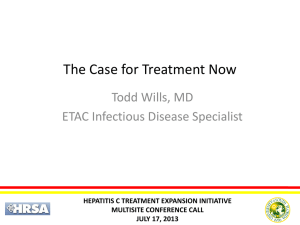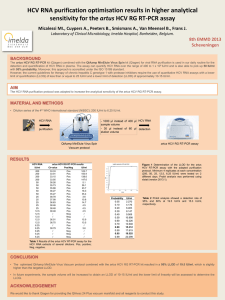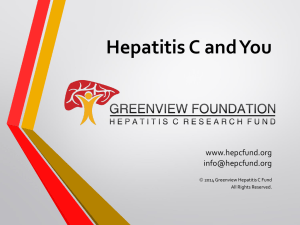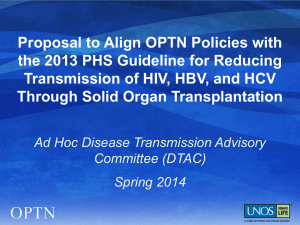HIV-Hepatitis C Virus Co-infection
advertisement
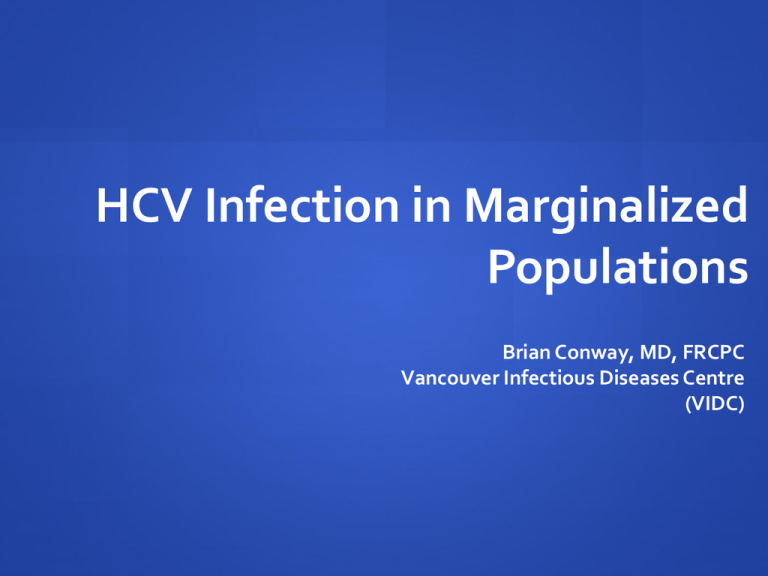
HCV Infection in Marginalized Populations Brian Conway, MD, FRCPC Vancouver Infectious Diseases Centre (VIDC) IDUs will drive the future HCV epidemic in Canada 300,000 HCV-infected Canadians, including over 180,000 IDUs (60% of prevalent cases) 14,000 new cases are diagnosed each year, including over 11,000 in IDUs (78% of incident cases) Traditional medical models (diagnosistreatment-prognosis) will NOT apply to their engagement in care and successful implementation of successful antiviral therapy Remis, Health Canada, 2004. Fischer et al. Can J Pub Health, 2006. Zou. Can J Pub Health, 2003. HCV Treatment Uptake Overall Overall treatment uptake is low in most places….. S. Mehta, with permission Treatment Uptake in HIV-HCV Co-infection N Canada (Vancouver) (Grebely et al. J Viral Hep 2008) United States (Baltimore) (Mehta et al. AIDS 2006) Australia (NCHECR 2005) 1,361 845 2,500 Cohort HCV Treatment Uptake Urban clinic of HCV & HIV/HCV co-infected patients 1.1% Urban clinic of HIV/HCV co-infected patients 3.4% Needle exchange 4.0% NCHECR, 2003. Australia. Grebely et al. J Hepatology, 2006. Barriers to HCV Treatment Structural Barriers • • • • Lack of infrastructure/multidisciplinary support Segregated services Provincial regulations Cost Provider Barriers • • • • Poor awareness/education Reticence to treat IDUs Lack of providers, especially in remote communities Focus on HIV Patient Barriers • • • • • Poor awareness/ education Lack of symptoms Competing health priorities (HIV, psychiatric) Competing social priorities (housing, substance use, financial) Fear of side effects Example: Overcoming structural barriers: Integrated care / co-location of HCV & Substance abuse treatment Co-location of HCV care with methadone maintenance has been associated with favorable outcomes (One-stop shopping) Integrated services for HCV, addiction, mental health and psychosocial problems Some programs Incorporate peer educators • Peer educators are patients who have successfully completed HCV treatment • Peers lead support groups with medical providers • Provide support through all stages from HCV screening to treatment Sylvestre 2007; Harris 2010; Litwin 2007; Edllin 2006; Grebely 2010. S. Mehta, with permission Canadian situation 2007 Canadian consensus guideline reads: An appropriately funded multidisciplinary effort is required to improve care strategies for HCV infected IDU. Antiviral therapy should be considered in selected patients in whom HCV related morbidity & mortality will become relevant. BUT 80% of Canadian physicians specialized in treating viral hepatitis would not treat active drug users Myles et al. Can J Gastroenterology, 2011 Academic & Community Partnership Care Model In the community Community & Academic Partnership ONE STOP SHOP Multidisciplinary Physicians (addiction & hepatology) Nurses Outreach workers Research assistants Culture of research & excellence Patient Characteristics and Response Rates Mean age 43, 83% male, 55% genotype 2/3 Early discontinuation - 11 patients (28%) Treatment-limiting adverse events – 5 patients (13%) nausea/vomiting, tinnitus, neutropenia, depression, anemia Illicit drug use – 6 patients (15%) 100 % Response 80 70% 55% 60 40 20 0 n=40 n=40 ETR SVR Grebely et al. J Gastroenterology and Hepatology, 2007. Impact of Illicit Drug Use on Response 35% used illicit drugs in the last 6 months 48% used illicit drugs during treatment 10 (25%) used occasionally (monthly or once/twice) 9 (23%) used frequently (every day/every other day) 100 80% 80 64% %SVR 60 57% 50% 53% 40 22% 20 0 n=26 n=14 >6 mos 6 mos Drug Abstinence n=21 n=19 n=10 n=9 None Any Occ Freq Illicit Drug Use During Treatment Grebely et al. J Gastroenterology and Hepatology, 2007. Occurrence of Viremia in IDUs After adjusting for potential confounders: Individuals with viral clearance were 4 times less likely to develop infection than those infected for the first time THESE DATA MAY NOT (OR MAY) APPLY TO TREATMENT-INDUCED VIROLOGIC CLEARANCE Grebely et al. Hepatology, 2006. VIDC Baseline Characteristics Characteristic Total treatment cases, (n) Median Age in yrs (Range) Female, n (%) HIV co-infection, n (%) n (%) 302 53 (34-70) 44 (15) 43 (14) HCV genotype, n (%) Genotype 1 Genotype 2/3 189 (63) 113 (37) Treatment experience, n (%) Naïve Experienced 252 (83) 50 (17) Liver Cirrhosis, n (%) 33 (11) History of recent IDU, n (%) 302 (100) On methadone maintenance therapy, n (%) 211 (70) Number of patients initiating treatment N=302 SVR rates in all treated and evaluable patients N=251 Treatment Discontinuation in all treated and evaluable patients; n=251 Genotype 1 N=155 Genotype 2/3 N=96 Overall N=251 Completed Therapy 95 (61%) 72 (75%) 167 (67%) Discontinued due to: 60 (39%) 24 (25%) 84 (33%) • Lack of Response 37 (24%) 7 (7%) 44 (17%) • Drug Toxicity 13 (8%) 14 (15%) 27 (11%) • Non-adherence / drug relapse 10 (7%) 3 (3%) 13 (5%) HCV Treatment Discontinuation Rates in IDUs vs. non-IDUs Lee et al. (Liver Int. 1270-77, 2012) 8853 courses of Peg-IFN-2a in non-IDUs 68.3% completion rate 10.3% discontinuation for toxicity Conclusions HCV infection can be treated successfully in IDUs with response rates and patterns of treatment discontinuation similar to those seen in other populations, independent of HIV co-infection status. As reflected in the 2012 Canadian guidelines for the treatment of HCV infection, IDUs should be considered for HCV therapy when this is medically indicated, preferentially within the context of multidisciplinary community-based models for the delivery of health care where state-of-the-art expertise for the management of HCV infection is available. EnTEnTE Engage: Take people who are not involved in their own health care and get them involved Test: Offer HCV testing in a setting favouring patient engagement Engage: Once a test result is available, use it to establish a long-term clinical relationship Treat: Optimize conditions to achieve SVR Engage: Towards a long-term solution to social inequality THE (NEAR) FUTURE Test all marginalized populations for the presence of HCV infection Select “optimal” patients for HCV treatment NOW Continue to engage non-treated patients in ongoing models of care Seek & Treat models MUST be developed for HCV, with a realistic expectation of disease eradication in selected communities, given the increasing efficacy of available treatment modalities
